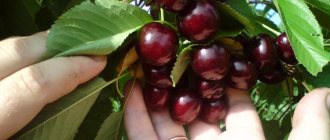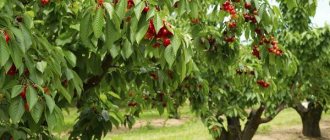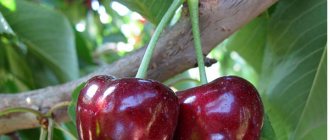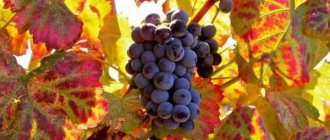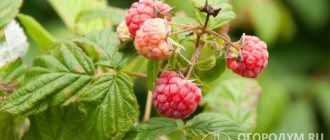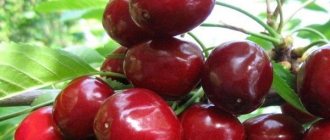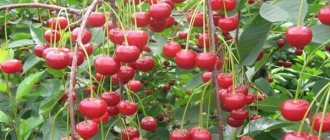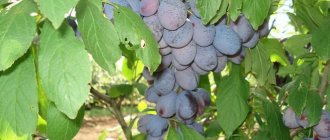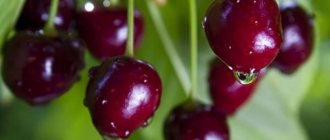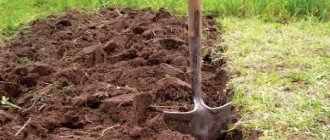Description and distinctive features of the Yaroslavna cherry variety
The variety was bred in 1956 by breeders of the Institute of Horticulture, located in Donetsk. Since then, it has gained great popularity among experienced and novice gardeners, so it is grown not only in small summer cottages, but also on a large scale.
Did you know? Bees can collect up to 35 kg of pollen from 1 hectare of cherries.
The description of the Yaroslavna variety is presented below:
- An adult tree reaches a height of 3.5–4.5 m and is characterized by rapid growth.
- The crown of the cherry tree has a round shape and is moderately dense. On powerful brown shoots there are matte, ovoid-shaped and medium-sized leaves. They are dark green in color and have jagged edges.
- The flowering period falls in the first half of May. At the same time, small (up to 3 cm) flowers with white and pink petals bloom on the tree. They are collected in umbrella-shaped inflorescences and exude a pleasant, subtle aroma.
- Large berries grow on elongated stalks, and each of them weighs 8–12 g.
- The fruits are round in shape and covered on the outside with thick dark burgundy skin.
- The pulp of the berry is dark red, with a dense structure. It tastes sweet and juicy, with a slight sour aftertaste.
- Inside each berry there is a small round seed that is easily separated from the pulp.
Productivity
The Yaroslavna cherry variety is an early ripening variety - the berries can be picked at the end of June. With proper care, each mature tree produces a high yield of ripe fruits that have a good presentation.
The main characteristics of fruiting and yield of the variety in question are as follows:
- the tree begins to bear fruit 5 years after planting the seedling;
- in the first year of fruiting, 20–30 kg of berries can be collected from each cherry;
- the maximum yield of a tree is achieved in the 10th year of its life - such specimens produce up to 100 kg of berries;
- from 1 hectare of plantings you can collect about 119 centners of fruits;
- fruiting is regular, without interruptions;
- berries are characterized by one-dimensionality.
Important! The total lifespan of Yaroslavna cherries
—
up to 25 years old.
Frost resistance
The southern regions are best suited for growing Yaroslavna cherries, but this variety can successfully bear fruit in any climatic conditions. Mature trees can withstand short-term drops in air temperature to -36°C, but in areas with severe and prolonged frosts it is recommended to cover them before the onset of winter. Young seedlings are especially sensitive to the effects of low temperatures.
Best pollinators
The Yaroslavna variety needs pollinators, so other types of cherries need to be planted next to it. Such trees should be located at a distance of no more than 50 m and be approximately the same age as the pollinated specimen. It is best to plant them around Yaroslavna cherries - this will help to significantly increase the yield of the crop.
Learn how to tell the difference between sweet cherries and sweet cherries.
The best pollinators for this variety are:
- Valery Chkalov;
- Donchanka;
- Donetsk beauty;
- Valeria;
- Aelita;
- Ethics;
- Melitopol early;
- Drogana yellow.
How the variety was bred
Cherry variety Yaroslavna was bred in the 1970s of the last century by breeder L. Taranenko. The species was obtained from seedlings of Drogana yellow in the Donetsk branch of the University of Horticulture UAAN. The variety of cherry tree immediately became popular in its homeland, and later gained recognition in the countries of the former USSR.
General description of the tree
The tree grows of medium height, with a round bush of medium density. The branches are spreading, arched, thick, brown in color. The leaf blade is medium-sized, egg-shaped, dark green in color. The corolla of the flower is white, 3 cm in diameter. The tree grows up to 3.5 meters high. When in bloom, the garden is decorated with snow-white and pinkish flowers, creating a romantic atmosphere.
Pros and cons of cherries
The Yaroslavna cherry variety suggests a number of positive and negative traits. Getting to know them will help you assess the situation and make a choice. The negative aspects can be easily mitigated if you properly care for the tree.
| pros | Minuses |
| Resistance to frost and dry periods | The tree has low resistance to fungal infections |
| Fruits are easy to transport | Pollinators required |
| Every year the tree produces a lot of fruit | |
| Fruits do not crack |
Berries
The cherry is large, slightly tapering towards the top, dark red in color. The stone is small in size and easily separated. The weight of one cherry is 7-8 grams. The pulp is juicy, dark scarlet, sweet. It contains 13% dry elements, almost 10% sugar, 9 mg/% vitamin C, and also contains iron, vitamin P, copper, and carotene. The fruits received a tasting score of 4.9 points and tolerate transportation well. They are consumed fresh or prepared for the winter. They widely prepare jams, jams, compotes, add cherries to baked goods or decorate fruits with them.
The period of tree flowering and cherry ripening
An early ripening cherry variety begins to bloom at the end of May, the berries ripen by the end of June or beginning of July. The tree bears fruit 4-5 years after planting; up to 20-30 kg of cherries can be harvested from one specimen. Peak yield is observed after 10 years of crop life. With good care, a maximum of 100 kg can be harvested from a tree. The variety is perfect for growing for personal consumption or sale. It is widely grown on industrial sites.
Drought resistance
The cherry tree normally tolerates dry periods, but if they are not long-term. The crop loves moisture; in the absence of the proper amount of watering, the number of fruits decreases, the plant loses its ability to resist diseases and attacks of harmful beetles.
Frost resistance
The cherry variety can withstand up to 36 degrees of frost, but for a short time. If there are long-term frosts in the region, the plant should be covered with oxygen-permeable materials. Otherwise, freezing of the crown, trunk, and deterioration of the condition of the tree is possible.
Tree disease resistance
Cherry Yaroslavna has a strong immune system, but only if you take diligent care of it. The plant is resistant to coccomycosis, and fungal infections sometimes attack the crop.
Basic soil requirements
The cherry variety prefers to grow in fertile, slightly moist soil. The plant does not tolerate close groundwater or increased soil acidity. If the acid level is less than 7.0, liming of the soil is required. You will need 7-10 kg per planting hole. Buy lime in advance.
See also
How to effectively combat aphids on cherries with drugs and folk remediesRead
Advantages and disadvantages of the variety
Chereshnya Yaroslavna compares favorably with others in many positive characteristics. That is why it is very popular among gardeners and is distributed throughout Ukraine and Russia.
- The main advantages of the variety are the following qualities:
- high productivity;
- early ripening of berries;
- excellent product characteristics and sweet taste of the fruit;
- resistance of berries to cracking;
- good transportability;
- high frost resistance;
- unpretentiousness to climate conditions;
- stable immunity to common diseases and pests;
- universal use of berries (fresh, in cooking, cosmetology and folk medicine).
Important! The maximum single serving of cherries for an adult is 300 g. In larger quantities, these berries can cause bloating.
- Among the few disadvantages of the variety, gardeners name:
- reduced immunity of trees to fungal diseases;
- the need for pollinators;
- large tree height, making harvesting difficult.
How many cherries to eat
With the onset of the cherry ripening season, many are in a hurry to buy large quantities of this sweet and beloved berry, which is certainly healthy.
However, an important question is: how many cherries can you eat, especially for children, per day? Let's look at the positive and negative aspects.
Ripening cherry berries (photo)
It is useful to eat cherries fresh, as they slightly tones the nervous system, activates the heart, urinary system and stimulates the intestines.
However, too hard cherry skin and fiber can irritate the gastrointestinal tract.
You should not eat unripe or slightly rotting cherries - this causes inflammation of the pancreas and intestines. This is especially dangerous for children.
The daily intake of cherries at the beginning of the season should be limited to several berries and increased to 100 g for children, and 100-150 g for adults.
Features of planting and growing
The variety in question is quite unpretentious to climate conditions, and its cultivation does not require much effort from the gardener. To successfully cultivate Yaroslavna cherries on your plot, it is enough to choose the right place for planting trees, purchase high-quality planting material and strictly follow the technology of planting fruit seedlings in open ground.
Dates and place for landing
In the southern regions, it is preferable to plant cherries in the second half of October, a month before frost, so that the tree has time to adapt to open ground conditions. In regions with cool and temperate climates, it is best to plant trees in the first half of March, before the buds open.
The site for planting Yaroslavna cherries must meet the following requirements:
- good illumination by the sun - its rays stimulate the growth of seedlings, and also ensure the formation and ripening of large berries;
- the selected location should not be located in a low area - water can stagnate there, and excess moisture has a detrimental effect on the roots of the tree;
- a sufficient amount of free space - the crown of the tree is very voluminous and forms an extensive shadow on the site with a diameter of up to 4 m;
- the depth of groundwater must be at least 3 m from the surface - as a result of constant flooding, the root system of the seedling will begin to rot;
- absence of cold drafts - they can weaken the tree’s immunity;
- nutritious and slightly moist soil of neutral acidity - chernozem, loamy or sandy loam soil that allows water and air to pass to the roots is best.
Important! The air temperature at the time of planting cherries should be at least +10
°
WITH.
Selection of the best seedlings
The quality of seedlings directly determines their survival rate on the site and the volume of the future harvest. Manufacturers offer the widest range of young trees in the fall, but if necessary, purchases can be made in the spring.
It is recommended to purchase seedlings only in specialized stores or from trusted sellers, choosing specimens for planting based on the following characteristics:
- Seedlings that have reached the age of 1 year take root best in the soil - they usually have 1 main conductor and 5-6 side branches;
- A healthy tree has elastic roots, without growths, rot and dried areas;
- the grafting site should be clearly visible on the lower part of the trunk - it confirms that the selected specimen is not a wild tree species;
- In a high-quality seedling, the bark on the trunk is even and smooth, without mechanical damage or stains.
Site preparation
You need to start preparing a place for Yaroslavna cherry seedlings in the fall. Preparation includes adding the necessary substances to the soil, as well as digging planting holes. They are prepared at least 2 weeks before planting, and if this procedure is planned for spring, then holes for seedlings are dug in the fall.
Did you know? The Middle East is considered the birthplace of cherries - it was there that the ancient Romans first saw the described culture.
To properly prepare a place for growing this crop, you need to perform the following steps:
- remove plant debris and debris from the soil;
- dig the area to a depth of 30–40 cm, adding 12 kg of humus per 1 m² of area, as well as 100 g of superphosphate and potassium sulfate;
- if the soil has a high level of acidity, it is recommended to lime it - for this, add 0.4 kg of dolomite flour or wood ash per 1 m²;
- dig planting holes about 80 cm deep and at least 1 m in diameter, leaving a distance of at least 3–4 m between them;
- Place a drainage layer of crushed stone or pieces of broken brick at the bottom of the recess;
- mix the top part of the soil obtained by digging a hole with 7 kg of compost, 180 g of superphosphate, 60 g of potassium sulfate and 450 g of wood ash;
- Drive a wooden support about 1.5 m high into the center of the bottom of the recess, and then form a mound around it from the prepared mixture of soil and fertilizers;
- pour 10 liters of water into the bottom of the planting hole and leave a hole for the soil to settle - you can cover it on top with a film to better retain moisture in the soil.
Direct landing
The process of planting cherry seedlings of the Yaroslavna variety does not have any distinctive features. In order for young trees to take root safely in the soil, you need to be careful when working with their root system, protecting it from damage.
Step-by-step instructions for planting cherries of the described variety are presented below:
- Prepare a thick mixture of clay and water for the roots - it should have the consistency of thick sour cream.
- If the root system of the seedling has dried out, you need to soak it in water for several hours. Immediately before planting, dip the roots in a clay mash.
- Place the tree in the planting hole so that its root collar is at a height of 4–5 cm above the soil surface. Gently spread the roots on the surface of the mound.
- Sprinkle the seedling with the remaining soil and compact it around the trunk to form a trunk circle with a diameter of about 60 cm.
- Tie the cherry tree to a support and water the tree with 20–30 liters of water. When the liquid is completely absorbed into the soil, cover the surface of the tree trunk circle with a layer of peat or sawdust about 5–7 cm thick.
Southern beauty – early ripe sweet cherry Yaroslavna
There is such a game. For each letter chosen, three fruits, vegetables or berries are named. For example, three berries on “h”. Answer: bird cherry, chokeberry, chokeberry. Cherries. You say this word, and your lips involuntarily stretch into a smile. And how can you not smile! Juicy, aromatic berries sparkle invitingly with an elastic barrel. How great it is in the summer! You can continue the game, developing your horizons, but it’s better to climb a tree and pick up ripe berries. Here stands a cherry tree with dark, as if lacquered berries, Yaroslavna. The game is over, beauty, hold on!
Rules for caring for cherries
In order to harvest ripe and sweet berries every year, you need to stimulate the growth and development of the seedling. To do this, the tree is regularly watered and fed with fertilizers, as well as branches are pruned and the cherries are insulated before the onset of frost. The basic rules for caring for the variety in question are discussed further in the article.
Did you know? Cherry pits are not recommended for consumption - they contain amygdalin, which, after entering the intestines, is converted into hydrocyanic acid.
Watering
Cherry Yaroslavna belongs to drought-resistant varieties of fruit crops, but even it needs moisture for growth and fruiting. It is especially important to properly water young seedlings and mature trees at the stage of crop formation and ripening.
It is recommended to water the crop at least 3-4 times per season, adhering to the following rules:
- It is imperative to irrigate the trees when the ovaries form - a lack of moisture in the soil at this stage will lead to a significant decrease in yield;
- water consumption for each tree depends on its age - to water young seedlings you need 10–20 liters of liquid, and with each subsequent year this amount increases by another 10–20 liters;
- in the summer, when there is a long absence of rain, cherries are watered 1-2 times - this promotes uniform ripening of the crop and gives the berries a good taste;
- you need to pour water into the area near the trunk, and in order for the moisture to be better absorbed by the roots, it is recommended to loosen the soil around the trunk before irrigation;
- It is best to irrigate trees in the morning, using warm water previously heated in the sun;
- the last watering is carried out in the fall after harvesting - in this case the roots are saturated with moisture, which helps the cherry tree to better survive the winter;
- After the liquid is completely absorbed into the ground, the space around the trunk is covered with a layer of humus or peat - this slows down the evaporation of moisture.
Trimming
Proper pruning helps to thin out the crown of the fruit tree, ensures normal access of sunlight to all fruits and is a necessary procedure for preventing the appearance of diseases and pests. In an adult specimen, old and damaged branches, as well as excess shoots, must be removed annually.
Important! In the first few years of growth of a young seedling, a crown of the correct shape is formed, consisting of 3-4 tiers.
Yaroslavna cherry pruning is carried out according to the following rules:
- Immediately after planting, the top of the seedling is cut off at a height of 80–90 cm from the ground, and its side branches are shortened by 50%.
- It is recommended to trim frostbitten shoots at the end of May - this procedure can only be performed in warm and dry weather to avoid gum development.
- Formative pruning is carried out in early June, leaving a trunk at least 60 cm high.
- As the seedling grows, the central conductor is shortened annually by 15–20 cm - this stimulates the growth of the cherry crown in width.
- During the first years after planting, the seedlings are formed with 1 tier of skeletal branches per year - for each of them, several of the strongest shoots are selected, growing in opposite directions at a distance of at least 15 cm from each other.
- The distance between adjacent tiers of skeletal branches should be about 60–80 cm;
- Each year, growth on the main lateral branches of the tree is shortened by about 30% to stimulate the growth of new shoots.
- From an adult tree that has reached the age of 5 years, remove small branches that grow too close to each other or towards the center of the crown.
- Autumn sanitary pruning is carried out at the end of September - only dry and old branches are removed.
Pruning cherries should be done with a sharp and disinfected tool, and all cut surfaces should be immediately treated with garden varnish to prevent infection.
Top dressing
At different stages of growth and development, Yaroslavna cherries need different types of nutrients. They help the tree form green mass, ensure high yield and sweet taste of berries.
Important! The following spring, after planting the cherry tree, while digging up the tree trunk, 200 g of urea is added to a depth of 10–15 cm to enrich the tree with nitrogen.
The main rules for fertilizing adult crops are listed below:
- After the tree has reached the age of 4 years, ditches up to 25 cm deep are dug around it and liquid fertilizer solutions are poured into them.
- Mature fruit-bearing trees are fertilized in early spring - a liquid solution of ammophosphate (30 g of fertilizer per 10 liters of water) is added to each of them.
- In May, cherries are fed 3 times with a solution of urea or ammonium nitrate (30 g of the substance per bucket of water) - the interval between feedings is about 10 days.
- During the autumn digging of the soil around the trunk, 30 kg of humus, 120 g of potassium sulfate and 400 g of superphosphate are added to each tree.
- To maintain a neutral level of soil acidity, it needs to be limed every 5 years - about 400 g of wood ash is added per 1 m².
Preparing for winter
Cherry Yaroslavna shows good resistance to cold and tolerates even very severe frosts well. But in order to protect the trunk and shoots of the tree from freezing, as well as to prevent them from being damaged by rodents, it is recommended to properly prepare cherries for winter.
It starts in September and includes the following activities:
- cleaning the soil around the trunk from debris, weeds and fallen berries;
- digging up the soil around the tree in order to destroy pest larvae overwintering in the ground;
- mulching the soil around the cherry tree with humus, peat or sawdust - the thickness of the mulch should be about 10 cm;
- tying the lower part of the trunk with several layers of thick paper, nylon or burlap protects the trunk from frost and rodents;
- whitewashing the trunk and the bases of the lower skeletal branches - protects the cherry bark from sunburn and pests.
Features of cultivation and subtleties of care
Cherry Yaroslavna is quite easy to care for. Like any tree, it needs watering, fertilizing and pruning. In general, all these events do not have any varietal characteristics, so we will not dwell on them. Let's talk about pruning in more detail. Since the tree of this variety has great growth power, the suitable form for the crown is sparsely tiered. Rules for this formation:
- The first step was taken during planting - the central conductor was trimmed.
- In early spring of the next year after planting, the first tier of the tree is formed. To do this: 2-3 good shoots are selected on the trunk (they will become skeletal branches) that meet the following conditions:
- The lower shoot is located at a distance of 30–40 cm from the ground.
- Shoots grow in different directions.
- The distance between them is 10–15 cm.
- All buds below the first selected shoot are blinded.
- Branches, except those chosen as skeletal ones, are cut into a ring.
- The remaining shoots are shortened by 30–40%.
- The central conductor is cut at a height of 10–15 cm above the base of the upper branch.
Yaroslavna cherries are pruned so as to create a sparsely tiered crown shape.
All other pruning (sanitary, thinning, rejuvenation) is carried out according to the usual rules.
Recent Entries
5 working ways to use tar in the garden 7 indoor plants that help you get married even in adulthood Indoor plants that can bloom in trouble
Video: how to properly care for cherries
Diseases and pests
If the site for growing Yaroslavna cherries was chosen taking into account all of the above requirements, and the trees were properly cared for, then the likelihood of the crop being affected by diseases or pests is low. But if a problem occurs, the gardener must be able to recognize the signs of infection in time and begin immediate treatment.
Did you know? Green food coloring is made from ripe cherries.
The main diseases and pests that can affect the Yaroslavna variety are listed below:
- Fruit rot (moniliosis) . A sign of this fungal infection is a gray-yellow coating on the berries, which subsequently leads to blackening of the fruits and their premature falling. Affected berries are immediately removed from the tree, and the crown is sprayed with a 1% solution of Bordeaux mixture.
- Bacterial cancer. This disease can not only reduce the yield of cherries, but also completely destroy the tree. The main sign of infection is brown watery spots on the bark and fruits, which gradually increase in size and infect the entire tree. Shoots damaged by the disease are pruned in spring and autumn, taking about 6 cm of healthy wood. The cut areas are thoroughly treated with a 1% solution of copper sulfate, and then covered with garden pitch.
- Coccomycosis . The disease affects cherry leaves, covering them with brown spots that increase in size. Gradually, the entire crown of the tree turns yellow and falls off prematurely, and the ovaries and fruits fall off. To combat infection, cherries are sprayed with a 3% solution of Bordeaux mixture.
- Cherry fly . This pest lays eggs on the tree, from which small caterpillars emerge. They damage the pulp of the berries and make them unsuitable for use, reducing the yield of the variety by 90%. To combat the pest, special traps made of plywood sheets are used, on the surface of which glue is applied. If there are a large number of pests, the cherry crown is treated with insecticides (for example, Actellik).
- Black aphid. The pest is small in size and settles on cherry leaves, sucking the juice from them. This leads to the fact that the green mass of the tree begins to turn yellow prematurely, the leaves fall off, and the crop yield decreases. To exterminate insects, the crown of the cherry tree is sprayed with infusion of tomato tops (2 kg of greens per 5 liters of water). In case of severe damage, special preparations are used (for example, Actofit).
- Cherry pipe roller. This insect harms the ovaries and fruits of cherries, and also damages the kidneys. The caterpillars hatched from tubeweed eggs feed on the pulp of the fruit and eat the buds and buds of the tree from the inside. If the number of insects is small, you can manually shake them off the tree, but in case of large-scale damage, insecticides are used (for example, Aktaru).
To prevent the occurrence of these difficulties, the following preventive measures are carried out:
- autumn digging of earth around a tree;
- removing fallen leaves and debris from the tree trunk;
- correct pruning of branches;
- compliance with the watering and fertilizing schedule;
- whitewashing the trunk;
- disinfection of cracks on the surface of the bark with a 5% solution of copper sulfate;
- spraying cherries with copper-containing preparations before flowering and after harvesting the berries.
Important to know about cherries
Cherry flowers are bisexual, but the plant itself is absolutely sterile. To get a harvest, he definitely needs 2-3 trees, which will serve as pollinators. Cherry fruits are true drupes.
Cherry fruits (photo)
For cherries, it is completely normal to form two types of shoots: shortened and normal elongated.
If at first the young tree has shortened shoots and it seems to have stopped growing, do not rush to remove it; next year strong branches will certainly develop from the lower buds.
In addition, cherries have three types of buds, and not two like other plants: generative, vegetative and mixed.
Cherry is a valuable early flowering honey plant. Up to 35 kg of honey is collected from 1 hectare of plantation. Thus, the cherry orchard and apiary are a mutually beneficial neighborhood of plants and insects. Bees help pollinate cherry flowers, although the presence of wind for pollination is also important.
Cherry seeds contain fatty and essential oils that are used in perfumery and liqueur production. The leaves contain a lot of vitamin C - up to 250 mg/%. Gum often forms on the trunks and is used for finishing fabrics. The bark contains tannins and can be used as a strengthening agent in the absence of other drugs.
Harvest and storage
The harvest of sweet berries begins in late June or early July. The fruits on the tree ripen at the same time, so they need to be picked in 1-2 steps so that they do not have time to crumble to the ground.
Important! To increase the shelf life of berries, they can be frozen or used to prepare canned preparations.
The basic rules for collecting and storing berries of the described variety are listed below:
- the berries are picked by hand along with the stalks - this helps to increase the shelf life of the product;
- the cherries are carefully placed in prepared containers, protecting the berries from shock and mechanical damage;
- Fresh fruits can be stored in the refrigerator for 3-4 days.
Cherry Yaroslavna is one of the best varieties that even a novice gardener can grow on his own. To reap a generous harvest of large and sweet berries, you must follow the planting and care recommendations listed in the article, as well as eliminate diseases and pests in a timely manner.
Tree pollinators
In order for cherry ovaries to form successfully, planting nearby pollinators is required. Such trees include:
- Donetsk beauty;
- Donchanka;
- Valery Chkalov;
- Annushka;
- Drogana yellow;
- Aelita;
- Ethics;
- Melitopol early.
It is undesirable for the cherry varieties Early Rozovinka and Sis to be near cherries. Pollinator trees should be located in the garden no more than 50 m from Yaroslavna, if possible, on different sides from it. It is better that these are plants of the same age, or older, but not young.
Characteristics of the variety and taste of the berry
The miracle cherry combines the best “parental” qualities regarding growth, productivity, and fruit quality.
Cherry is highly resistant to pest damage. Characteristic characteristics of the variety:
- trunk height – from 3 to 4 meters;
- the appearance of the crown resembles a cherry;
- the branching method is spreading, like that of a cherry;
- the leaf is dense, like a cherry, similar in color and shape to cherry;
- laying flower buds - on one-year growths, on bouquet branches;
- berries - from 7 to 10 grams, dark red.
The pulp of the fruit is red, juicy, sweet, with a cherry aroma.
Like most hybrids, Duke is not capable of self-pollination.
To form ovaries, it is necessary to plant pollinators, the best of which will be cherries (with the exception of the “parent”).
According to the description of the listed properties, the variety is considered the best among dukes and has become widespread.
Frost resistance
The tree can withstand frosty periods with temperatures of 15-20 degrees. With stronger cold temperatures, flower buds suffer. When grown in the conditions of the Moscow region, the Middle Zone, the hybrid must be covered - both the root system and the crown. It is necessary to form the crown below the varietal level to be able to save it from frostbite.
Immunity
The main enemies of cherries are fungal infections of leaves, flowers and the cherry fly. The plant, due to the loss of foliage, enters winter weakened, reducing the yield and quality of fruits. The cherry fly is a pest whose larvae feed on ripe fruits.
Duke Miracle cherry is resistant to the listed mycotic lesions. It is not affected to the same extent by pests, but for prevention it requires spring treatment with antifungal agents. Digging the soil under the trees and spraying the green ovaries help prevent cherry flies.
Ripening time and harvest abundance
Duke inherited Valery Chkalov's early fruiting and stable yield from the cherry tree. The berries acquire removable ripeness a month after pollination ends. After a week or two (depending on weather conditions) – consumer ripeness.
Removable ripeness means that the berries have acquired varietal characteristics in color, size, and can be transported and stored for 5-7 days. But the fruits truly taste when they reach consumer maturity. Ripe, juicy fruits are stored in the refrigerator for no more than 2 days, during which they must be processed or eaten.
Productivity depends on weather conditions in winter and during flowering. Temperatures below 25 degrees, as well as spring frosts, can damage flower buds. On average, up to 15 kilograms of berries are harvested from one tree 4-5 years after planting.
Flowering and pollination period
Cherry is an early ripening variety. In the south, flowering begins before May 15, in the northern regions - at the end of May and beginning of June. At this time, the cherry blossoms are just beginning to develop flower buds. The flowering period of the Iput, Annushka, Yaroslavna cherries coincides with the appearance of buds on the duke, which makes them most suitable for pollination.
Like all cherries, the flowers on the hybrid bloom and fade almost simultaneously. The pollination period is 10 days. Rainy weather, cold weather, lack of bees, and windless weather affect crop yields.
Description and features of the tree
The description of the plant includes such characteristics as height, crown, pollination, flowering, yield, fruiting and storage of berries.
Crown height and branching
The trees are low-growing, reaching a height of 4-5 meters. They grow and develop quickly, gaining a height of up to 1 meter in one year. The crown is round or oval, raised. The branches grow sparsely. The shoots are woody, straight, dark brown in color. The leaves are large, green, lanceolate-shaped. The surface of the leaf plate is smooth, matte, the edges are wavy.
Pollinator varieties
Chermashnaya cherry is a self-sterile variety. To obtain an ovary, it must be planted next to pollinating trees.
Important! The flowering of the pollinator and the cherry tree should occur during the same period. Pollinator varieties include:
Pollinator varieties include:
- Raditsa;
- And the way;
- Crimean;
- Chocolate girl;
- Crimean;
- Bryansk pink;
- Leningradskaya black;
- Fatezh.
Flowering, fruits, yield
The period of fruit ripening begins in the third year of vegetative development. Until this time, it simply blooms and gains strength. It produces white flowers, which consist of 5-6 petals, with a yellow core. One inflorescence contains from 2 to 6 flowers. Afterwards the fruits are formed. Flowering occurs before leaves begin to form.
Produces fruits of medium size, light yellow in color; with increased access to sunlight, the berries have a pink tint. The maximum weight of one berry is 4.5 grams. The shape of the fruit is round. The pulp is juicy, sweet, yellow. The skin is dense, inside there is a small seed that is easily separated.
The highest yield occurs in the 6th year of development. Up to 30 kg of fruits are harvested from one tree. The average age of the Chermashnaya cherry is 25 years. The ripening of berries occurs in several stages, so the harvest is harvested gradually.
Transportability and scope of application of berries
Most often, cherries are used fresh. It is also processed into compotes, jams, and preserves. Berries are stored in a cool place for up to 4 days. If it is necessary to freeze the berries, it is advisable to save the cuttings, then they can be stored for up to 4 months. After defrosting, they retain their sweet taste.
Growing
Growing cherries is not difficult. The growing process consists of:
- purchase and selection of seedlings;
- choosing and preparing a landing site;
- the landing itself;
- care
Selection of seedlings
When purchasing seedlings, you need to pay attention to the appearance of the plant and its root system. The tree must be healthy and undamaged, and its roots must be well developed. A strong 2-year-old seedling is ideal for planting.
Site preparation and planting
Cherry Yaroslavna is not picky about the location and composition of the soil. But in order for the tree to grow well and bear fruit, it is best to choose a dry and fertile area well illuminated by the sun. If the soils are poor, they need to be fed. The site is prepared 2 weeks before planting - the soil is dug up and cleared of roots and grass, fertilized and holes measuring 80 X 80 are prepared.
Broken bricks are placed at the bottom of the holes, then a layer of fertile soil mixed with mineral and organic fertilizer. A seedling is placed on a small mound of the mixture, the roots are straightened and covered. Next they compact, water and mulch.
Characteristic
The Yaroslavna variety was bred in 1956 by Ukrainian breeder L.I. Taranenko.
from crossing Melitopol hybrids with the Drogana yellow variety. Cherry variety Yaroslavna high (4 m). The crown is round and moderately dense. The shoots are brown, of medium thickness. It blooms with small white flowers, green leaves with a dense texture. Fruits are formed both on annual shoots and on older branches.
The Yaroslavna variety has large fruits (12 g), with a dense but thin skin. The berry is dark burgundy, round, fleshy with a medium-sized stalk and juicy pulp. It tastes sweet and sour.
Spring will come soon and a new gardening season will begin. Many of us are thinking about purchasing cherry seedlings for planting in our summer cottages, but not everyone knows which variety is best suited for our climate and soil composition.
Currently, there are many different types of crops specifically for regions with cold winters, but which one should you choose so that it not only has decent yield and winter hardiness, but is also unpretentious in cultivation? Yaroslavna cherries are not only able to withstand the winter even in the most severe cold, but they will also delight you with an abundance of large and tasty berries.
Photo of Yaroslavna cherry.
Yaroslavna is a mid-early cherry hybrid native to the Donetsk region. It was obtained in 1956 as a result of pollination of the Drogana Yellow cherry with Melitopol hybrids of the culture. The author of the variety is the famous Ukrainian scientist-breeder Lydia Taranenko, who has many inventions to her credit. Yaroslavna cherry was included in the State Register of our country only in 1997 for cultivation in the republics of the North Caucasus, but the hybrid can be found almost throughout the entire territory of Russia, right up to its northern regions.
What does a tree look like?
Yaroslavna cherry trees are medium-sized and spreading:
- they reach a height of 3.5 meters and above;
- arched brown shoots of medium thickness form a ball-shaped crown;
- tree leaves are shiny, dark green. The leaf shape is egg. The edges are jagged, the ends are pointed;
- the tree trunk is covered with smooth dark brown bark;
- in early May, cherries are completely covered with small white flowers, forming inflorescences of 3-5 pieces. Trees bloom for 10 days;
- plants of the variety are self-sterile. For pollination, they need other types of crops nearby - Valery Chkalov, Donetskaya Krasavitsa, Drogana Zheltaya, Aelita, Valeria, Donchanka, Ugolyok, etc.;
- The variety begins to produce harvests 4-5 years after planting the tree;
- Yaroslavna cherries live for 30 years or more.
Yaroslavna is characterized by large fruit:
- the berries reach large sizes. The weight of one is 7-12 g;
- fruit shape - round-conical, color - dark red;
- juicy, fleshy pulp of medium density is covered with a thin but very durable skin;
- There is a medium-sized bone inside that is well separated from the pulp;
- The taste of Yaroslavna fruits is harmonious, very sweet, with a slight sourness.
The berries of the variety (per 100 g) contain:
- sugars - no more than 13%;
- acids - 0.65%;
- ascorbic acid - 9 mg;
- dry ingredients - 23%.
The taste of Yaroslavna berries is rated highly - 4.8 points on a five-point scale.
Application
Cherry berries are loved and awaited by everyone, both children and adults. Fresh cherries are everyone's favorite summer treat. Delicious preserves are also made from the fruits of Yaroslavna, of which there are about a dozen varieties; compote and juice are also prepared from them, as well as jam and marmalade. Cherries are used in desserts and baked goods, and homemade wine is made from overripe berries.
When it ripens
Cherry Yaroslavna belongs to the mid-early varieties. Its growing season from the moment of bud break is 115-120 days. The berries begin to ripen at the end of June, and by the beginning of the next month ripening reaches its climax. At this time, you can start collecting fruits. If the berries are not removed in time, they will hang on the branches for some time and will not fall off. The fruits of the variety are resistant to cracking in unfavorable weather.
Hybrid plants are characterized by high frost resistance (up to -35 degrees). Moreover, in winter, tree bark, shoots and flowering buds also do not freeze. Resistance to drought and temperature changes is also excellent. The trees tolerate both cool, humid weather and severe heat, which makes it possible to cultivate Yaroslavna cherries in almost all regions of our vast Motherland, including Siberia and the Far East.
The yield of the hybrid is simply amazing. Trees bear fruit starting from the 5th year of life. By the age of 12-15, the yield reaches its peak - it is during this period that up to 100 kg of delicious berries can be collected from one tree. When grown on a commercial scale, up to 120 centners of fruit are harvested from one hectare.
Yaroslavna berries are characterized by excellent keeping quality due to their strong skin that is not prone to cracking. Berries can be stored in the refrigerator for about 2 weeks. All these properties of the hybrid, plus excellent transportability, make it possible to grow this type of crop on an industrial scale.
Reviews about the cherry variety
Feedback about Yaroslavna cherries is mostly positive. They will help you evaluate the variety realistically.
Kristina Ostapets, 35 years old, Kyiv.
Hello! In 2013, I planted Yaroslavna cherries on the plot. The plant is unpretentious in care, which is good for summer residents. I had 3 such trees on my site, from which I collected 15 kg of fruit. Cherries are always sweet, juicy, without sourness. I recommend this variety to everyone.
Pavel Lavrentiev, 58 years old, Kazan.
Greetings! I have been interested in gardening for 10 years. Yaroslavna cherries have been growing in my garden since 2010. The tree ripens early, by mid-June. Cherries are always juicy; I treat them to my work colleagues and make excellent compotes. The plant never got sick, although it was attacked by weevils. I destroyed them in 2 approaches using chemicals. I am completely satisfied with the culture, I recommend it to everyone!
Features of the Revna cherry variety
With proper planting and care, the Revna cherry quickly begins to grow, and in 4–5 years the tree forms a crown of medium density and height. Thanks to the skeletal branches extending from the trunk at a large angle, the plant is strong enough to withstand abundant fruiting, which begins just from the age of 5.
In spring, the shoots of the cherry tree are covered with large, ovate leaves with pointed tips, a rounded base and highly serrated, double-serrated edges. On the leathery dark green surface, relief veins are visible, turning into a dense short petiole. It, like the young shoots, is almost completely colored in brownish-green tones.
On this topic:
BACK
FORWARD
1 of 11
The cherry variety Revna is characterized by late flowering. Up to 80% of flowers collected in 4-5 pieces open on bouquet branches. The white-petalled corollas have a wide-open, saucer-like shape. A pistil surrounded by stamens is clearly visible in the center. Due to its excellent winter hardiness in the harsh winters of the Central region, the cherry is slightly damaged.
History of the variety
Cherry Yaroslavna was obtained in the seventies of the last century by breeder Liliya Ivanovna Taranenko. The variety was bred from seedlings of Drogana yellow in the Donetsk branch of the Institute of Horticulture of the UAAS (Ukrainian Academy of Agrarian Sciences). The fate of Liliya Ivanovna, Honored Agronomist of Ukraine, who worked here in the same position for more than sixty years, is surprising.
Over the years, from dozens of varieties L.I.
Taranenko 21 are zoned, of which 19 are in Ukraine and six are in Russia. Taranenko stone fruit varieties are grown in the CIS countries, Western Europe, China, and the USA. One of her plum varieties was produced in the late 1980s. gold medal at the Erfurt exhibition in Germany. She is the author of more than 100 scientific articles. But, for all her achievements, Lidia Ivanovna was not even a candidate of science. https://orehovod.com/articles/105-vyraschivanie-greckogo-oreha-na-donbasse.html
Having such selective “fertility”, Lidia Ivanovna chose to remain a practicing gardener, infinitely devoted to her work, until her death in 2012.
Honored breeder, author of the Yaroslavna cherry variety, Lidia Ivanovna Taranenko
Here is a list of Lydia Taranenko’s varieties that domestic gardening can be proud of:
- Cherry - Early pink, Dzherelo, Valeria, Yaroslavna, Farewell, Lesya, Donetsk beauty, Vasilisa, Donchanka, Annushka, Aelita, Ethics, Katyusha, Donetsk coal, Sister, Amazon, Student (early fruiting, excellent taste, with a fruit weight of up to 8– 9 g, some - up to 12–14 g).
- Cherry - Miracle cherry, Shpanka Donetskaya, Nochka, Donetsk giant, Ksenia, Temptation, Slavyanka (fruit weight of some varieties is from 7 to 9 g).
- Plum - Sinichka, Renklod early, Renklod Karbysheva, Hungarian Donetsk early, Hungarian Donetsk, Donetsk canning.
- Thorn - Donetsk thorn, Donetsk thorn large.
- Cherry plum - Super early, Chernushka, Donchanka early, Mashenka, General, Tatyana, Plum-shaped, Velvet, Harmony, Foundling, Lemon, Sunny bunny.
- Apricot - Son of Tabarza, Frost-resistant, Donetsk sweet core.
- Peach - Donetsk white, Donetsk yellow, Stark seedling.
- Quince - Donetsk pear-shaped.
- Apple tree - Calvil Donetsk (surpassed its parent - Renet Simirenko - in early fruiting and productivity).
Since 1997, Yaroslavna cherries have been included in the State Register and recommended for cultivation in the North Caucasus region and Crimea.
Comparison of popular cherry varieties
Photo and description
The German cherry variety is successfully cultivated in warm regions of the country up to the Middle Volga region. This is ensured by two important qualities of Regina - resistance to frost and disease. The tree grows up to 3.5-4 meters, has a crown of medium branching and density.
general description
Regina is classified as an unpretentious variety, therefore it is successfully grown on large farms. Flowering and fruit ripening occur annually. The tree blooms at the end of May, the fruits ripen at the end of July, Regina is a late-ripening variety that ends the cherry season.
Cherries can be stored on the tree for a long time, which is important for busy summer residents; they store well and are transported without loss of taste. The fruits do not leak juice and do not become wet.
Advantages
The list of benefits of the variety is quite impressive:
- taste, beauty and decorativeness of fruits;
- long-term storage without loss of quality, ensured by dry separation;
- annual fruiting of cherries;
- ripe fruits remain on the tree for up to 2 weeks.
Let us also note the very relevant properties of this cherry variety for Russia - winter hardiness and resistance to fungal diseases.
Flaws
Gardeners consider the only disadvantage of Regina to be the need to plant a pollinator, without which it will not be possible to obtain fruits.
Bud
Cherry buds develop late and tolerate frost well at any stage of development. Sawflies are especially dangerous for the buds and can greatly harm the tree.
Leaf and flower
The sheets have a traditional shape - an ellipse, the end is slightly pointed. The edges are serrated. The surface of the plate is glossy and shiny.
The flowers are collected in 2-3 pieces, the petals are white, the cherry blossoms are abundant and friendly.
Fetus
The fruits are round-heart-shaped, evenly and uniformly colored.
Color
Exquisite dark cherry color and shiny glossy skin attract attention to large fruits. The pulp is slightly lighter than the cherry shell
Taste qualities
Regina's taste qualities are close to ideal - score 4.8-5 points. The taste of cherries is sweet, with a slightly noticeable sourness.
